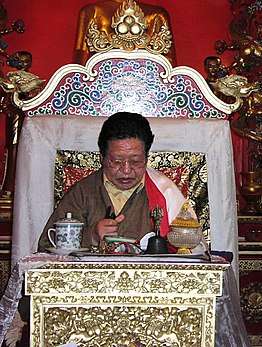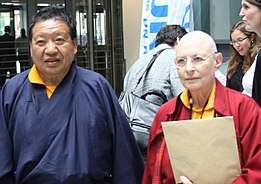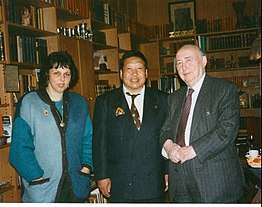Akong Rinpoche
| Chöje Akong Rinpoche | |
|---|---|
 Akong Rinpoche at his 65th Birthday celebration in 2005 | |
| Religion | Tibetan Buddhism |
| School | Kagyu |
| Lineage | Karma Kagyu |
| Personal | |
| Nationality | British |
| Born |
25 December 1939 Dharak Village, Riwoche, Kham, Tibet |
| Died |
(Murdered) 8 October 2013 (aged 73) Chengdu, China |
| Religious career | |
| Teacher |
|
| Reincarnation | Akong Lama[1] |
| Website | http://samyeling.org |

Chöje Akong Tulku Rinpoche (25 December 1939 – 8 October 2013) was a tulku in the Kagyu school of Tibetan Buddhism and a founder of the Samye Ling Monastery in Scotland.[1]
Early life
He was born in 1939, near Riwoche 31°12′41.76″N 96°36′0.89″E / 31.2116000°N 96.6002472°E in Kham, Eastern Tibet. At the age of two he was discovered by the search party seeking the reincarnation of the previous (1st) Akong, Abbot of Dolma Lhakang monastery 31°10′0.38″N 97°13′59.61″E / 31.1667722°N 97.2332250°E near Chamdo. The search party was following instructions given by the 16th Karmapa. Following Akong's death, Rumtek Monastery issued a statement clarifying his status as rinpoche. According to the statement, Akong was a tulku of a noted and respected ngagpa who had founded and developed the Dolma Lhakang temple. There are no records of previous Akong Rinpoches, either as meditators or scholars. Akong was given the title of Chöjé Lama, a traditional title, by the 16th Karmapa in 1974 in recognition of Akong's service in developing Samye Ling.[1]
At four he was taken to Dolma Lhakang to receive an education that included religion and traditional Tibetan medicine. When only a teenager he travelled, performing religious ceremonies and treating the ill. Later he went to the great monastic university of Sechen where he received transmission of the Kagyu lineage from Sechen Kongtrul Rinpoche, one of two tulkus of the first Jamgon Kongtrul. He also received instruction from the 16th Karmapa, who also certified him as a teacher of Tibetan medicine.[2]
In 1959, in the aftermath of that year's Tibetan Rebellion, he fled to India at age 20. Of the 300 in his party only 13 arrived successfully in India.[2] They were so hungry after running out of food on the journey that they had to boil leather shoes and bags to make soup.[3][4]
After spending time in refugee camps he was asked to teach at the Young Lamas Home School in Dalhousie, NW India. In 1963, a sponsor paid for Akong Rinpoche and Chögyam Trungpa Rinpoche to go to Oxford to learn English. As only Trungpa had a bursary, Akong worked as a hospital orderly in the Radcliffe Infirmary in order to support himself, Trungpa and Lama Chime Tulku Rinpoche (who had joined them at Oxford).[2]
Work and writings
He introduced Western people to Tibetan religion and culture, and in 1967 he co-founded Samyé Ling in Scotland with Trungpa Rinpoche. In addition, he helped found ROKPA International, an international humanitarian organisation that works principally in Tibet and Nepal. The charitable aims of ROKPA are: "To promote Buddhism and to foster non-sectarian inter-religious dialogue and understanding. To provide medical care and therapy. To provide education. To relieve poverty."[5]
In 1992, Akong Rinpoche was one of the main people to discover one of the two claimed reincarnations of the 16th Karmapa, Urgyen Drodul Trinley Dorje, and took him to two of the regents, Their Eminences Tai Situ Rinpoche and Goshir Gyaltsab Rinpoche[6] responsible for locating the reincarnation.

Akong Rinpoche produced a book with his student Clive Holmes titled Taming the Tiger:Tibetan Teachings for Improving Daily Life.[7] The book aims to help those seeking the truth about suffering and happiness. The first part deals with Buddhist teachings (and how they relate to life in the 'Western world'), while the second part is devoted to exercises, meditations and relaxation techniques for body and mind, and includes exercises designed to provide a base of self-knowledge, mind-therapy and self-healing used in therapy workshops and in the treatment of psychological problems.[8]
In 2009, he gave a presentation on Tibetan medical treatments using mantras and prayers at the Seventh International Congress on Traditional Asian Medicine held in Bhutan. It is likely that he presented this at least partly in Tibetan, according to the Congress programme.[9][10] Akong Rinpoche's younger brother Lama Yeshe Losal Rinpoche, has now taken over some of his duties as abbot of Samye Ling.
Subsequent visits to China

In 1992, Akong was given the opportunity to visit his native Tibet. This was largely due to Beijing implementing an open-door policy that allowed foreign fact-finding missions and investment. This visit, and others, led to Akong launching a series of humanitarian projects in Tibet through his international charity, Rokpa.[11] Rokpa claimed to be the largest NGO preserving Tibetan language, culture and religion on the Tibetan plateau.[12][13] In order to make his Tibetan humanitarian work effective, Akong was obliged to maintain good working relationships with government officials in China.[14][15] In October 2006 in London, he met with Jia Qinglin, number four in the Chinese regime and Chairman of the National Committee of the Chinese People's Political Consultative Conference (CPPCC) and member of the Politburo Standing Committee.[16]
In August 2011 Akong Rinpoche was among the honored guests in Lhasa at the invitation of the Communist Chinese during the 60th Anniversary of the Peaceful Liberation of Tibet functions.[17] In a video posted to YouTube of the celebrations, Akong Rinpoche is shown together with other "Patriotic Tibetans" such as Gangchen Tulku.[18]
Death
On 8 October 2013, it was reported that Akong Tulku Rinpoche had been killed in "a dispute over money" in Chengdu, China, along with two other monks, including Rinpoche's nephew, and his driver.[19][20] The police said that three Tibetan men had been arrested and admitted carrying out the killings.[21][22] The Samye-Ling website subsequently said that the killers had intended to rob Akong Rinpoche of funds which were being distributed to various projects supported by the charity, Rokpa International, for which he was responsible. It was also announced on 11 October 2013 that his body was being taken to the Tibetan Autonomous Region, to his monastery (Dolma Lhakang), for a ceremony and cremation in accordance with his high standing.[23] On 12 October 2013 Samye-Ling released a statement confirming that one of the suspected killers had been named by Chengdu police as Tudeng Gusha, also known as Thubten Kunsal, who had spent some five years in the UK and who had made religious statues at Samye Ling and an associated centre in London. In its statement, the Samye Ling centre strongly rejected claims that this individual was owed money by either Akong Rinpoche, the centre or its London centre.[24][25] Gusha's trial was held in August 2014. Akong's family sought clemency over a death sentence, saying that the crime was intolerable but that Buddhism promoted non-violence. The court reserved its decision for a later date.[26][27]

References
- 1 2 3 "Statement from the Rumtek Office concerning Akong Rinpoche". Rumtek Monastery. Archived from the original on 7 June 2015.
- 1 2 3 Karma Triyana Dharmachakra. "Kagyu Teachers – Dr. Akong Tulku Rinpoche profile". Archived from the original on 1 February 2011. Retrieved 6 February 2011.
- ↑ Kagyu Samye Ling. "About: Dr. Akong Tulku Rinpoche". Archived from the original on 24 July 2011. Retrieved 6 February 2011.
- ↑ Trungpa, Chogyam (2000). Born in Tibet (4 ed.). Boston: Shambhala Publications. pp. 224–25. ISBN 1-57062-116-0.
- ↑ "ROKPA trust". Charity Commission for England and Wales. Retrieved 29 August 2010.
- ↑ 12th Goshir Gyaltsap Rinpoche Archived 2007-11-03 at the Wayback Machine.
- ↑ Rinpoche, Akong Tulku; Clive Holmes (September 1994). Taming the Tiger:Tibetan Teachings for Improving Daily Life. Rider. ISBN 0-7126-6220-0.
- ↑ Searchresult. ASIN 0712662200.
- ↑ Akong Tulku Rinpoche (Shetrup Akong Tarap) (7–11 September 2009). Treatments with Mantras and Prayers (sgnags) (PDF). Seventh International Congress on Traditional Asian Medicine (ICTAM VII). Thimpu, Bhutan. Archived from the original (PDF) on 2011-07-23. Retrieved 2010-08-31.
- ↑ Akong Tulku Rinpoche (Shetrup Akong Tarap) (7–11 September 2009). Treatments with Mantras and Prayers (sgnags) (PDF). Seventh International Congress on Traditional Asian Medicine (ICTAM VII). Thimpu, Bhutan. Archived from the original (PDF) on June 10, 2015.
- ↑ Cohen, Yvan (20 October 2000). "Struggle for Tibet's Soul". Asia Week. Retrieved 6 November 2012.
- ↑ "NGO Projects". Retrieved 15 November 2014.
- ↑ "Please Donate to Tibet Earthquake Relief Efforts!". Retrieved 15 November 2014.
- ↑ "ROKPA: Home -". Retrieved 15 November 2014.
- ↑ "Archived copy". Archived from the original on 2015-10-04. Retrieved 2015-10-03.
- ↑ "Top Chinese adviser meets Tibetans in Britain". Retrieved 15 November 2014.
- ↑ China Uses 60th Tar Anniversary to Undermine Dalai Lama Archived 2013-10-19 at the Wayback Machine.
- ↑ Exile Tibetan Traitors Attends "60th Anniversary In Lhasa" (Akong Rinpoche pictured on far left at 1:31) on YouTube
- ↑ Samye Ling monks killed ITV.com News, 8 October 2013
- ↑ Eskdalemuir monastery founder Akong Rinpoche killed in China BBC Scotland, 8 October 2013
- ↑ Heather Saul, "British Tibetan Monk 'assassinated' in China", The Independent, 10 October 2013; retrieved 10 October 2013
- ↑ Wong, Edward (9 October 2013). "3 Arrested in Death of Tibetan Religious Leader in China". The New York Times. Archived from the original on 11 October 2013. Retrieved 11 October 2013.
- ↑ "3 Akong Rinpoche cremation ceremony planned in Tibet". British Broadcasting Corporation. 11 October 2013. Retrieved 12 October 2013.
- ↑ "Statement". Samye Ling (archive). Archived from the original on October 12, 2013.
- ↑ McElroy, Damien. "Former British resident held after Buddhist killed in China". The Daily Telegraph. Retrieved 12 October 2013.
- ↑ "Verdict due in Chinese court for men accused of the murder of the founder of Borders monastery". The Herald.
- ↑ "Family pleads for clemency for murderers of Buddhist". The Herald.
External links
- Dr Akong Tulku Rinpoche profile
- Masters and their Organisations: Dr. Akong Tulku Rinpoche
- Photo of the original Dolma Lhakang (Akong's monastery)
- Biography on the Kagyu Samye Dzong London website
- "Choje Akong Rinpoche (obituary)". The Daily Telegraph. 10 October 2013. Archived from the original on 10 October 2013. Retrieved 10 October 2013.
- N. D. (Shanghai) (12 October 2013). "Murder of a Monk (obituary)". The Economist. Archived from the original on 14 October 2013. Retrieved 14 October 2013.